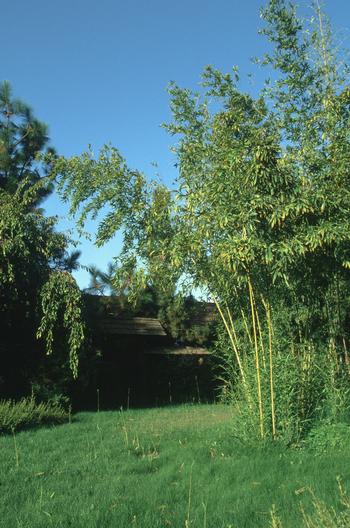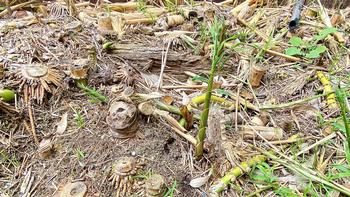Want a privacy screen? Avoid bamboo - your garden and neighbors will thank you.
-
Julie McMillan
-
You may believe planting bamboo will create a fast-growing privacy screen from your neighbors or the street. Although that may be true, bamboo has many more downsides: it is not good for fire-adapted gardens, it can be highly invasive, and it can travel far away from the original plant. Here are reasons to avoid bamboo, steps to take to get rid of it or try to control it, and some better alternatives.
 Examples of bamboo stalks growing far away from the original plant. Photo: Jack Kelly Clark, UC IPM Program
Examples of bamboo stalks growing far away from the original plant. Photo: Jack Kelly Clark, UC IPM ProgramBamboo is a big grass with more than 1,200 varieties. Once mature, a stalk can grow several feet a day. Most of the plant’s mass is underground. The tall, stately stems (called culms) are like the leaves and twigs of a tree; the trunk and branches are underground. Bamboo grows vigorously when planted near irrigated lawns and gardens or in low-lying areas that collect water.
Bamboo is not good for fire-adapted gardens or planted near homes. It loses moisture rapidly during hot, dry weather. It also accumulates fine, dead leaf litter, which can easily catch fire from blowing embers.
There are two types of bamboo: clumpers and runners. Clumpers spread much more slowly than runners. To get rid of clumpers, simply dig them out.
Running bamboo causes more serious problems. Runners produce “rhizomes,” which are continuously growing horizontal underground stems. These put out lateral shoots and roots at intervals. If this seems out of control, you’re right: rhizomes can generate new plants as much as 20’ away from the original plant. They may crowd and eventually exclude adjacent plants, including natives, and threaten biodiversity. They can also damage irrigation lines, and don’t respect fences or property lines, so your neighbors won’t be happy, either.
You’ll need years of vigorous and diligent effort to get rid of running bamboo. Because many of its horizontal shoots are close to the surface, the first step is to remove all pieces of the shoots, or regrowth will occur. Do this in early spring or late fall when soil is moist and roots are more easily removed. You may need to hire professional help to remove the root mass physically. After removing running bamboo, new growth can continue in unexpected places. Photo: Barbara Robertson
After removing running bamboo, new growth can continue in unexpected places. Photo: Barbara RobertsonFrequent mowing can deplete and starve bamboo. You can also cut the shoots close to the ground, then remove the regrowth each time they reach 20-24” in height. Success here depends on repeatedly exhausting the food reserves stored in the roots.
As a last resort, you may need a chemical control. Cut the stem of the bamboo close to the soil surface. Immediately after cutting, apply herbicide (glyphosate) with a paintbrush or a plastic squeeze bottle. Take extra care to keep it away from the plants you desire.
You need to install a root barrier to control running bamboo and prevent it from spreading. Bury thick polypropylene or fiberglass about 3’ deep and leave another 2” above the soil to inhibit surface spreading. Create a solid barrier made of concrete, metal, or pressure-treated wood at least 18” around the bamboo. Slant it outward at the top so that when the rhizomes hit the barrier, they bend upwards. Or dig a shallow trench and cut the rhizomes with a shovel when they cross this zone.
Frankly, no type of root barrier will provide complete control, and eventually, roots will grow under or through the barrier toward the soil surface. If you absolutely must have bamboo, plant it in a container.
Plant shrubs like privet or laurels instead for an immediate, cheap privacy screen. To be fire smart, choose plants with broad, waxy leaves that don’t accumulate dead material. Stagger the plants to create a break in the foliage to help prevent fire from spreading from plant to plant.


